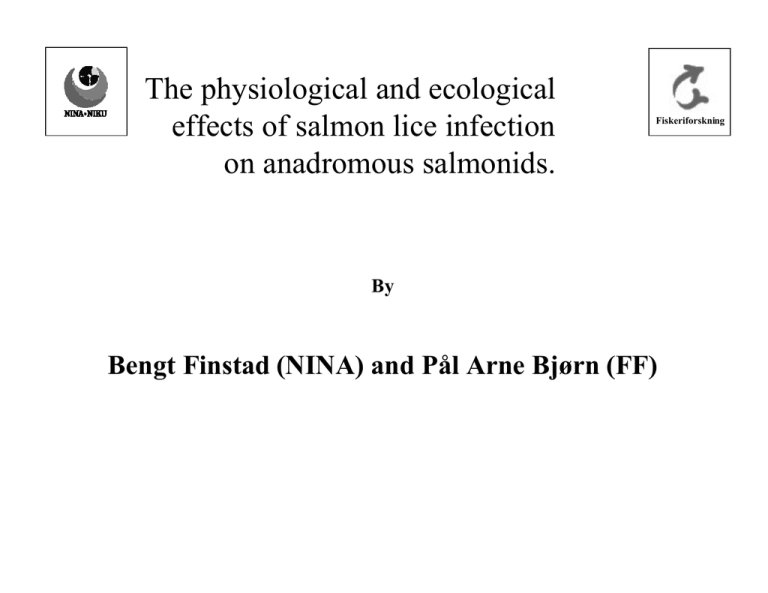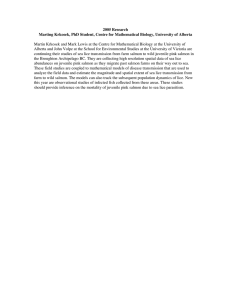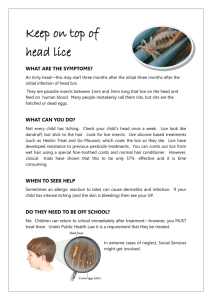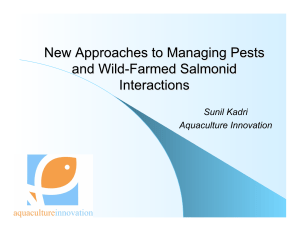The physiological and ecological effects of salmon lice infection on anadromous salmonids.
advertisement

The physiological and ecological effects of salmon lice infection on anadromous salmonids. Fiskeriforskning By Bengt Finstad (NINA) and Pål Arne Bjørn (FF) Wild sea trout infected by salmon lice Fiskeriforskning Wild sea trout infected by salmon lice Fiskeriforskning Life cycle of salmon lice Fiskeriforskning nauplius copepodid chalimus adult male preadult male preadult female adult female Aims (1993-1998) Fiskeriforskning • To test the survival time of salmon lice through a delousing process on fish in fresh water • To describe the development, distribution on the host and pathogenicity of salmon lice on sea trout • To test the physiological effect of salmon lice on sea trout and Atlantic salmon post smolts • To describe the salmon lice infection on wild Atlantic salmon, sea trout and Arctic char post smolts in areas with and without salmon farming activity, and consider possible effects of the infection. Fiskeriforskning Salmon lice registrations in Norway Survival of salmon lice on Arctic char in freshwater Total number of salmon lice on fish Fiskeriforskning 250 200 150 100 50 0 0 28 56 84 112 140 168 196 224 252 280 308 Time (hours) 504 Conclusions Fiskeriforskning (Finstad et al., 1995. Aquaculture Research, 26:791-795) • 60% of the salmon lice survived one week in freshwater. • Salmon lice may survive for up to three weeks in freshwater. • The delousing process was a continuos one. • The results imply that attached lice could maintain their salt balance by feeding on the host, and this may damage the host even during delousing in freshwater. Development of salmon lice 100 Fiskeriforskning Day 7, n=20 60 Frequency (%) 20 100 Day 14, n=20 60 20 100 Day 19, n=20 60 20 100 Day 24, n=20 60 20 100 Day 29, n=20 60 20 100 Day 38, n=20 60 20 CH1 CH3 P1M P1F P2M P2F ADM ADF Developmental stages Conclusions Fiskeriforskning (Bjørn and Finstad, 1998. Can. J. of Zool. 76: 970-977) • Male lice developed faster than female lice, taking 29 and 38 days, respectively, to reach the adult stage, but less than 40% of the lice reach the adult stage. • The chalimus larvae preferred the gills and the fins, especially the dorsal fin, and caused minor skin damages. • Preadult and adult lice stages preferred the head and dorsal areas of the fish, and caused severe skin damages. • Salmon lice seem to have more or less the same developmental rates, distribution on the host and pathogenicity as seen in Atlantic salmon. Mortality in lice infected sea trout post smolts Accumulated mortality (n) Fiskeriforskning 30 25 20 15 10 5 0 1 7 14 19 24 Days post infection 29 38 Relative density of lice on sea trout post smolts Relative density (lice/fish weight) Fiskeriforskning 3.0 2.5 infected 2.0 moribund 1.5 1.0 0.5 0 7 14 19 22-25 26-29 Days post infection 30-38 Plasma cortisol concentration in sea trout post smolts Fiskeriforskning Cortisol (nmol/l) 800 400 200 infected 100 control 0 7 14 19 24 Days post infection 29 38 Plasma chloride concentration in sea trout post smolts Fiskeriforskning Chloride (mmol/l) 260 240 infected 220 control 200 180 moribund 160 140 120 7 14 19 22-25 Days post infection 26-29 30-38 Conclusions Fiskeriforskning (Bjørn and Finstad, 1998. Nord. J. of Freshw. Res. 73: 60-72; Finstad et al., 2000. Aquac. Res. 31: 795-803) • Heavy salmon lice infections causes a stress response in salmonids, even at chalimus stages of the lice. • Chalimus stages, however, causes only minor osmoregulatory disturbances to the fish. • Preadult and adult stages of the lice causes severe osmoregulatory problems to the host, thereby leading to mortality with high infection. • The results on Atlantic salmon and sea trout post smolts, imply that a relative infection of 0.75 and 1.6 lice larvae per gram fish weight, respectively, can be suggested. Fiskeriforskning Wounds on wild sea trout caused by salmon lice Field sampling techniques Fiskeriforskning Experimental design Fiskeriforskning • Atlantic salmon post smolt were captured by a pelagic par-trawl. • Different zones of Trondheimsfjorden were trawled annually in May/June 1992 to 1998. • Salmon lice number and developmental stages on the fish were counted. N Zone 6 Zone 5 Zone 4 Zone 3 Zone 2 Zone 1 Trondheim Salmon lice infection intensity Year Zone Prevalence Mean >10 lice (%) Fiskeriforskning 1992 1993 1994 1995 1996 1997 1998 1 3 1 2 3 4 5 3 6 2 3 4 1 2 3 1 2 3 5 6 2 3 0 54 0 0 1.5 0 0 12 46 0 4 19 25 29 26 1 4 5 5 11 44 53 4.8 8 1 2.6 1.6 1 2.6 1.5 4.9 2.2 1.2 1.5 2 1.3 22 7.2 0.9 3.4 0.3 11.1 11.8 Conclusions Fiskeriforskning (Finstad et al., 2000. Aquac. Res. 31: 795-803). • Atlantic salmon post smolt may become infected with salmon lice during fjord migration. • The migrating post smolts were only infected with chalimus stages, and the infection level was generally low. • However, in some years, the infection level was higher, and indicated that salmon lice may be a possible cause of Atlantic salmon post smolt mortality. Experimental design Fiskeriforskning • Sea trout and Arctic char were captured in June, July, August and September 1997 at the exposed (Vik) and the unexposed area (Bogen). • Fish were gill-netted in the sea and sampled by electrofishing in freshwater. • At the exposed locality, sea trout captured both in sea and in freshwater were in addition blood sampled. Vik Harstad Bogen Narvik Exposed locality Sampling week Hab n Prev mean min max SW FW SW FW SW FW FW SW 27 12 27 11 14 19 1 3 89 76 96 91 93 95 100 33 Hab n Prev mean min max SW FW SW FW SW FW SW FW 21 3 11 2 9 0 16 1 61.9 0 54.5 0 88.9 1 1 4 6 1 13 6 2 12 68.8 100 13 1 36 Fiskeriforskning 26 29 32 37 123 133 203 206 53 45 6 8 11 1 10 1 0.3 1 445 279 471 532 101 160 13 1 Unexposed locality Sampling week 26 29 32 37 Plasma cortisol level in wild sea trout post smolts Fiskeriforskning Cortisol (nmol/l) 500 400 300 Habitat 200 100 SW 0 FW N= 5 14 6 2 7 12 low medium high Relative intensity (lice/fish weight) Salmon lice density on wild sea trout post smolt Relative density (lice/fish weight) Fiskeriforskning 10 8 6 Habitat 4 2 SW 0 FW N= 24 9 26 26 10 29 Week 13 18 1 1 32 37 Conclusions Fiskeriforskning (Bjørn et al., 2001. Aquac. Res. 32: 947-962. • The salmon lice infection is very high in the exposed area, and heavily infected sea trout tended to return prematurely to freshwater. • The salmon lice infection is low in the unexposed area, and few sea trouts were captured in freshwater. • Heavy salmon lice infection caused a stress response in wild sea trout, and 30-50% of the fish from the exposed locality is expected to suffer from physiological disturbances or mortality because of the infection. • Salmon lice may, therefore, have the potential to cause mortality of sea trout, and with time, may even render the population at the risk of eradication. Experimental design Fiskeriforskning • Sea trout and Arctic char were captured in sympatry at sea in June, July and August 1992 and 1993 at the exposed (Alta) and the unexposed area (Lille Porsanger). • Number of lice and developmental stages on the hosts were counted in the laboratory. Altafjorden Laksefjorden Lille Porsanger River Hals Exposed system Unexposed system Salmon lice abundance of all stages Fiskeriforskning Altafjorden 1992 Sampling week 26 29 32 n Prev mean min max 40 30 20 7.1 80.0 65.0 0.1 23.6 12.1 0 0 0 3 97 74 13 22 28 15.4 77.3 75.0 0.2 4.4 13.0 0 0 0 1 24 84 42 31 77 0 12.9 94.8 0.3 19.9 0 7 0 134 5 20 40 0 10.0 82.5 0.2 3.9 Laksefjorden 1992 26 29 32 Altafjorden 1993 25 28 31 Laksefjorden 1993 25 28 31 0 0 3 21 Conclusions Fiskeriforskning (Bjørn and Finstad, 2002. ICES. J. of Mar. Sci. 59: 131-139) • The salmon lice infection differed significantly between the exposed and unexposed area on both species. • The salmon lice infection also differed within and between years. • The infection pattern in the exposed area showed an epidemic tendency. • The results imply that salmon lice epidemics may also occur on Arctic char in the northernmost area of Norway. Summary Fiskeriforskning • Salmon lice were able to survive for up to 3 weeks in freshwater. • Adult males developed faster than adult females. Fourty percent survival up to adult stages were observed. Mobile stages caused severe skin damage. • Physiological studies showed that a relative density of 0.75 and 1.6 lice per gram fish weight led to mortality. Severe stress responses were also monitored. Summary (cont.) Fiskeriforskning • Salmon lice infection may cause mortality of fjord migrating Atlantic salmon post smolt in some years, although the infections mostly were low. • The salmon lice infection were, however, significantly higher in an exposed compared to an unexposed locality in Nordland county, and may affect the population severely. • The same tendency was also found at an exposed locality in Finnmark, and both Arctic char and sea trout seem to be susceptible to infections. • Considering some of these results, salmon lice must at present be regarded as a major threat to wild populations of salmonids in some areas of intensive fish farming activity. Fiskeriforskning New results (1999-2001), future strategies og research needs • Increased research and monitoring of salmon lice on farmed and wild salmonids. • Epidemiological studies and risks of infestation. • Strategies Monitoring of sea trout and Arctic charr; examples from 2000. Number of lice on wild salmonids Fiskeriforskning 60 13 50 40 9 30 14 12 10 20 1 11 8 10 3 2 47 5 6 15 0 -10 -10 0 10 20 30 40 Exposure index for farmed salmon 50 60 70 Fiskeriforskning Monitoring in bag nets - coast/fjord Monitoring of salmon lice on returning wild- and farmed Atlantic Fiskeriforskning 1997 Locality Type N Large Female Total W 92 5±9 5±3 9±6 18 ± 16 E 81 11 ± 18 6±5 12 ± 8 28 ± 24 W 18 64 ± 190 7±8 5±6 76 ± 192 E 104 130 ± 241 8 ± 11 6±6 145 ± 247 Large Female Total Coast Fjord Larvae 1998 Locality Type Coast Fjord N Larvae W 59 1±4 2±3 9±9 13 ± 11 E 58 7 ± 39 3±4 7±7 16 ± 39 W 26 32 ± 100 4±4 9±8 46 ± 102 E 219 39 ± 112 3±5 2±6 43 ± 115 Fiskeriforskning • Salmon lice - wild/farmed fish Average costs to produce 600 000 kg salmon* in 20 net pens á 10 000 salmon (Mustafa et al. 2001, Can. Vet. J. 42). * smoltprice Can$2.00. 1. Farm without sea lice problem 2. Farm with sea lice problem (no treatment) 3. Farm with sea lice problem (regular treatment) Can$ 3 600 000 Can$ 3 936 000 Can$ 3 696 000a Can$ 3 678 000b Can$ 3 708 000c 1-2= Can$ 339 000 1-3= Can$ 96 000 Can$ 78 000 Can$ 108 000 a Azamethipos Hydrogenperoksyd c Teflubenzuron b Meta project 2002-2005 Fiskeriforskning NRC salmon programme Growth and survival of Atlantic salmon National monitoring Escaped salmon and salmon lice Geographic Duration of residence in fjords EU, NINA & NRC Migratory routes Infestation studies Migratory routes Laboratory studies Modelling sites for “safe” establishment of fish farms Modelling wind and water currents NRC salmon programme Spread of salmon lice Water quality in freshwater FHF & NRC Water quality and smolts Migratory models Geographic variations AquaNet, NINA & Statkraft Migratory routes Risk of infestation





